Of all the early-spring-blooming wildflowers in the mid-Atlantic region, Virginia bluebells is among the most striking. It blankets the woodland floor with sky-blue flowers shortly after breaking ground in the first weeks of spring. After the nearly month-long show, the gray-green foliage dies back to the ground as the forest canopy develops. This is the typical life cycle of most of our spring ephemeral wildflowers. While it disappears completely by the time summer arrives, you can be sure that it will return again the following spring when it is most needed.
When I first got started with native plants in New England, Virginia bluebells was used in many display gardens. It was sort of a gateway plant to get people excited about natives. Now that I am down in the mid-Atlantic, the home turf of this species, I can find it growing wild. And it is glorious. Large swaths of woodland that were littered with dried leaves and twigs one week were transformed into a sea of green highlighted with stalks of sky-blue flowers.
Not only is this a beautiful wildflower for naturalized areas, but it also works very well in cultivated beds. Virginia bluebells likes moist but well-drained soils. The plants tolerate a wide range of soil acidities, with a pH from 4.8 to 8, which is a good fit with lawns and gardens that may get a lot of lime or are close to a concrete foundation where the pH levels are higher.
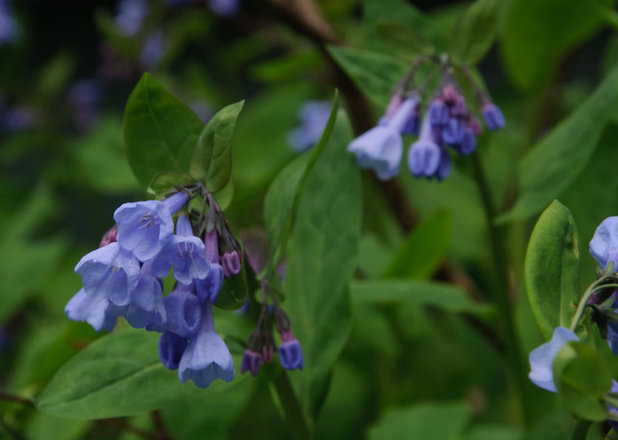
Barbara Pintozzi
Botanical name: Mertensia virginicaCommon names: Virginia bluebells, Virginia cowslip, lungwort oysterleaf
Origin: Native to the eastern U.S., primarily from New York south through Virginia to northwestern Georgia and west to Kansas; grows well as an introduced species in New England
Where it will grow: Hardy to -40 degrees Fahrenheit (USDA zone 3 to 8; find your zone)
Typical plant communities: Found mainly in moist deciduous woods, clearings and bottomlands in the eastern U.S.
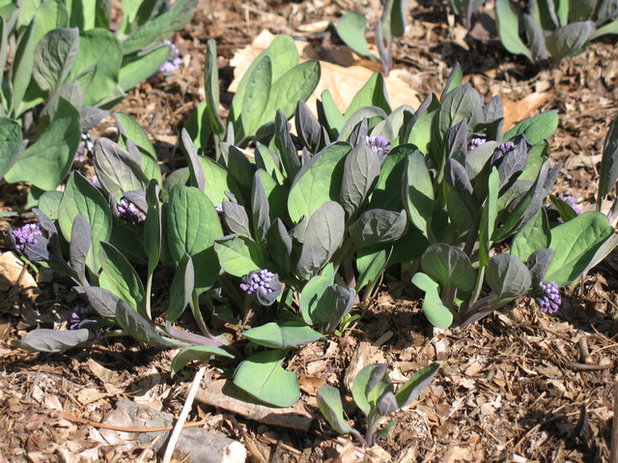
Missouri Botanical Garden
Water requirement: Does well in average to moist, well-drained soil
Light requirement: Partial sun to full shade; grows best in deciduous woods where it gets sun in early spring and then shade as the tree canopy develops; may be used on sunnier sites with sufficient moisture
Mature size: 1 foot to 2 feet tall with a spread of 12 to 18 inches
Benefits and tolerances: Tolerates clay and alkaline soils with a pH of up to 8; doesn’t mind growing in moist conditions; deer and rabbits tend to avoid this plant, making it a successful ground cover for spring; known to grow under black walnut trees
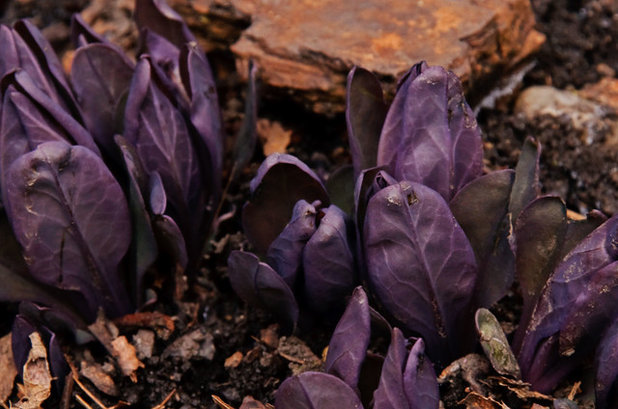
Barbara Pintozzi
Seasonal interest: New shoots appear in early spring; these bundles of tightly curled leaves often have a purplish cast to them and quickly unfurl and develop into gray-green foliage. Flowering occurs shortly thereafter; the flower buds are initially pink but turn blue as the bell-shaped flowers open up. Flowering is strong for about three weeks; depending on exposure, a clump of plants may be in bloom into early June. By early summer, when the tree canopy has developed, the foliage dies back to the ground and the plant all but disappears.
When to plant: Plant nursery-bought plants in spring. Wild plant populations have suffered in many areas due to improper wild harvesting; make sure any plants you buy are nursery propagated. Mature clumps can be divided after the plants go dormant in early summer.
This photo shows just how purple the new foliage can be.
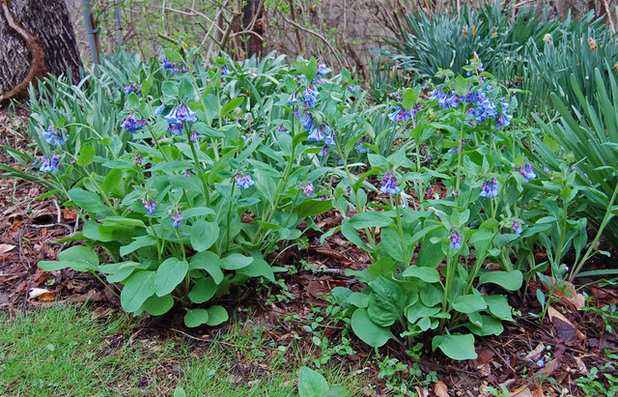 Distinguishing traits.
Distinguishing traits. The clusters of sky-blue bell-shaped flowers are Virginia bluebells’ most notable features. The flower buds are pink when they first develop, but the color shifts from pink to blue as the internal pH of the bud becomes more alkaline (higher pH). This color change is a signal to insects that the flower is ready for pollination. The flowers turn back to a light shade of pink as they age. In this photo the bluebells are in midbloom. There are spent blooms of some early daffodils and some jonquils that are just starting to bloom in the background.
Virginia bluebells has the largest flowers of all the North American
Mertensia species. There are several other species native to the western states (such as
M. alpina and
M. ciliata) and northern parts of North America (such as
M. maritima and
M. paniculata).
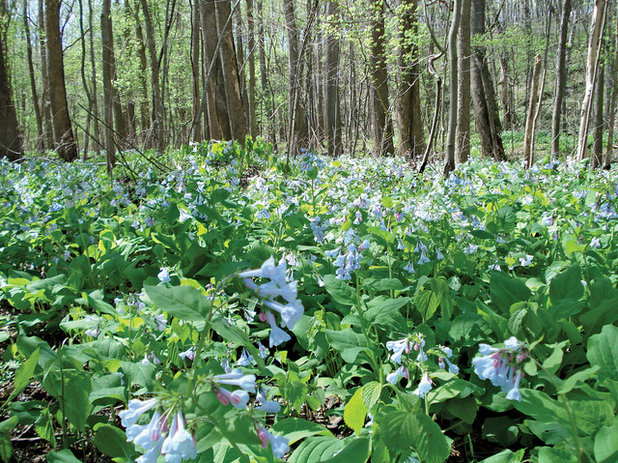
Missouri Botanical Garden
How to use it. Virginia bluebells is good to use with deciduous shrubs that leaf out a little late, or with larger perennials or ferns. A natural combination could include the yellow flowers of spicebush (
Lindera benzoin) with the blue of Virginia bluebells and a layer of ferns to fill in as the bluebells dies back. You could also combine it with the yellow flowers of celandine poppy (
Stylophorum diphyllum) or other plants with blue flowers, like woodland phlox (
Phlox divaricata).
Dicentra species also would provide an interesting contrast. Consider pairing bluebells with the frilly foliage and red hearts of wild bleedingheart (
D. eximia).
Some later-blooming perennials that would be good at filling in the space after it goes dormant include mistflower (
Conoclinium coelestinum), common boneset (
Eupatorium perfoliatum) and Joe Pye Weed (
Eupatorium fistulosum). You could also try some of the shade-tolerant asters, like bigleaf aster (
Eurybia macrophylla) or white wood aster (
E. divaricata).
This image shows how Virginia bluebells looks massed out in the woods.
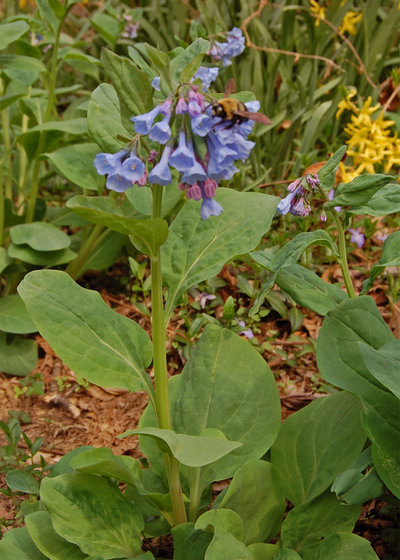 Planting notes.
Planting notes. Actively growing plants do not like to be disturbed. The best time to divide the clumps is when the plants are dormant, after the foliage has died back in summer. Allow cut areas on the roots to dry for a week before replanting. Clumps of plants spread mostly by reseeding, but they also spread by rhizomes.
It is best to plant fresh seed if you are growing bluebells from seed. The seeds are ripe three to four weeks after flowering. For purchased or stored seed, six weeks of cold, moist stratification is needed for good germination.
The flowers are pollinated primarily by bumblebees and other long-tongued bees. These early-spring flowers are an important food source for these native pollinators. Other species capable of reaching deep into the flower for nectar also visit these bluebells and include some butterflies, hummingbird moths and hummingbirds. Shown here is a native bumblebee visiting one of the bluebell flowers. In the background is a forsythia in bloom.
Virginia bluebells is available at many native plant nurseries as well as some regular retail nurseries. Bare-root plants can be ordered in late winter for planting as soon as the soil is workable.
More:Learn more about gardening with native plants in your area
See more blue-flowering plants





